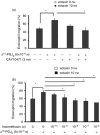Indomethacin inhibits eosinophil migration to prostaglandin D2 : therapeutic potential of CRTH2 desensitization for eosinophilic pustular folliculitis
- PMID: 23582181
- PMCID: PMC3809708
- DOI: 10.1111/imm.12112
Indomethacin inhibits eosinophil migration to prostaglandin D2 : therapeutic potential of CRTH2 desensitization for eosinophilic pustular folliculitis
Abstract
Indomethacin is a cyclo-oxygenase inhibitor, and shows therapeutic potential for various eosinophilic skin diseases, particularly eosinophilic pustular folliculitis. One of the unique characteristics of indomethacin is that, unlike other non-steroidal anti-inflammatory drugs, it is a potent agonist of chemoattractant receptor-homologous molecule expressed on T helper type 2 cells (CRTH2), a receptor for prostaglandin D2 (PGD2 ). This study investigated the pharmacological actions of indomethacin on eosinophil migration to clarify the actual mechanisms underlying the therapeutic effects of indomethacin on eosinophilic pustular folliculitis. Eosinophils exhibited chemokinetic and chemotactic responses to both PGD2 and indomethacin through CRTH2 receptors. Pre-treatment of eosinophils with indomethacin greatly inhibited eosinophil migration to PGD2 and, to a much lesser extent, to eotaxin (CCL11); these effects could be mediated by homologous and heterologous desensitization of eosinophil CRTH2 and CCR3, respectively, by agonistic effects of indomethacin on CRTH2. Indomethacin also cancelled a priming effect of Δ(12) -PGJ2 , a plasma metabolite of PGD2 , on eosinophil chemotaxis to eotaxin. Indomethacin down-modulated cell surface expression of both CRTH2 and CCR3. Hair follicle epithelium and epidermal keratinocytes around eosinophilic pustules together with the eccrine apparatus of palmoplantar lesions of eosinophilic pustular folliculitis were immunohistochemically positive for lipocalin-type PGD synthase. Indomethacin may exert therapeutic effects against eosinophilic skin diseases in which PGD2 -CRTH2 signals play major roles by reducing eosinophil responses to PGD2 .
Keywords: CCR3; Lipocalin-type prostaglandin D synthase; chemoattractant receptor-homologous molecule expressed on T helper type 2 cells; desensitization; eotaxin.
© 2013 John Wiley & Sons Ltd.
Figures







References
-
- Aoyama H, Tagami H. Eosinophilic pustular folliculitis starting initially only with palmoplantar pustular lesions. Report of a case and review of the literature. Dermatology. 1992;185:276–80. - PubMed
-
- Satoh T, Ikeda H, Yokozeki H. Acrosyringeal involvement of palmoplantar lesions of eosinophilic pustular folliculitis. Acta Derm Venereol. 2013;93:99. - PubMed
-
- Ishiguro N, Shishido E, Okamoto R, et al. Ofuji's disease: a report on 20 patients with clinical and histopathologic analysis. J Am Acad Dermatol. 2002;46:827–33. - PubMed
-
- Lee ML, Tham SN, Ng SK. Eosinophilic pustular folliculitis (Ofuji's disease) with response to indomethacin. Dermatology. 1993;186:210–2. - PubMed
-
- Ota T, Hata Y, Tanikawa A, et al. Eosinophilic pustular folliculitis (Ofuji's disease): indomethacin as a first choice of treatment. Clin Exp Dermatol. 2001;26:179–81. - PubMed
Publication types
MeSH terms
Substances
Supplementary concepts
LinkOut - more resources
Full Text Sources
Other Literature Sources
Medical
Miscellaneous

